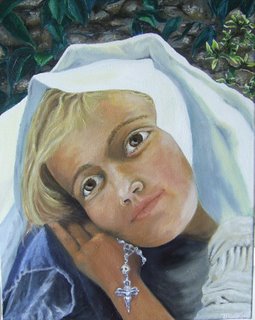
St. Catherine of Siena, as a young child, would sit around the family hearth at night and listen to the tales of the saints: she was inspired, with the generous heart God gave her, to seek after Him totally from this very young age.
She went so far as to retreat to the edge of Siena, where there was a cave, to be a hermit at about six years of age. She was persuaded to return home to live again with her family; but the Lord did not leave her longings unanswered. She was graced with heavenly visions from the time of her sixth year, the crowning moment of her life being her espousals with the Lord, from which she wore a ring that no one else could see. At the moment of her death, the tan line from the many years' wear of a supernatural ring became visible on her wedding finger.
She lived with and was tried by her family for the first years of youth, and then she was finally allowed her 'cave'; and lived the life of a hermit for a few years. She understood, by total gift, the balanced life that is a saint's: suffering balanced with the joy of contemplation; poverty balanced with the inexpressible riches of the Holy Sacrament of the Eucharist, where the Lord of Heaven and Earth comes bodily to us; and complete self-denial balanced with a fervent service and fruitfulness in the Lord's vineyard.
There are many facets of this great saint's life, this Doctor of the Church (let no one say the Holy Church is misogynist), this woman who persuaded the Pope himself to return to Rome: but I wanted to capture the essence, in a sense, of her childhood, in which the spiritual one coincided with the bodily.
She has been saying the rosary, and is out away from society, symbolic of the doe that frolics in the verdant pasture of King Solomon; and she is caught in the moment of contemplating the Lord- whether with the eyes of her body or her soul, or both, it is the same. It is the look of absolute, passionate and tender love. It is a reflection of His gaze upon the soul He loves. It is the way He looks at you.
If you notice the rosary, it has upon it a memento mori. This was a common practice, the inclusion of a human skull in art (many have seen the Magdalen Contemplating the Skull) and in sacramentals. This was a reminder, in the deep sense of St. Alphonsus Ligouri, that inextricably tied with loving the Lord and gaining one's own life, is to understand and to accept one's own death: death to self, death of the body, death of one's own desires.
"If you lose your life, you will gain it"- and the Lord lived this first for us: not only in the ultimate sense on the Cross, but also in His very 'emptying of His glory, to become like a slave'. He was showing us, in accepting death, the many kinds, that Love knows no bounds, no limits, no height nor depth: but will go to death and beyond.
Death is also a reminder that we are sinners and must continually ask mercy of the Lord, to sustain us, especially at the hour of death. We have free will until the moment when we appear before Him, and so we must keep watch, and a sober one. A memento mori is meant to help the praying one keep all of these thoughts close to the heart: and remembering death is tied to moving toward the only life that counts: that of seeing the Lord face to face.